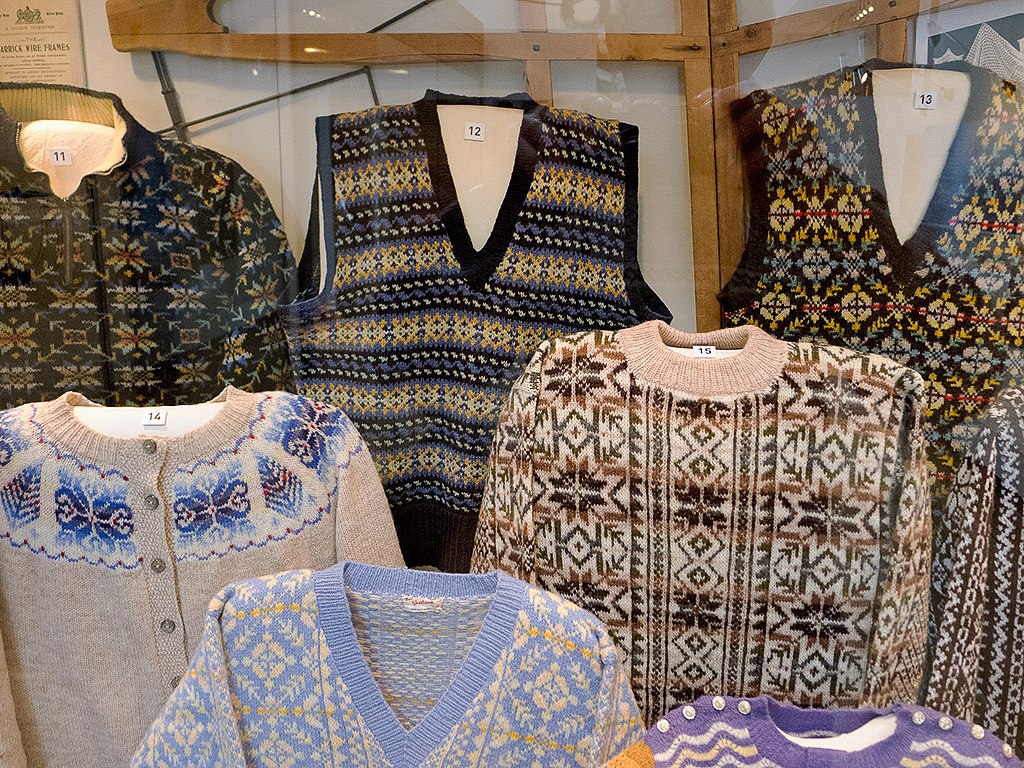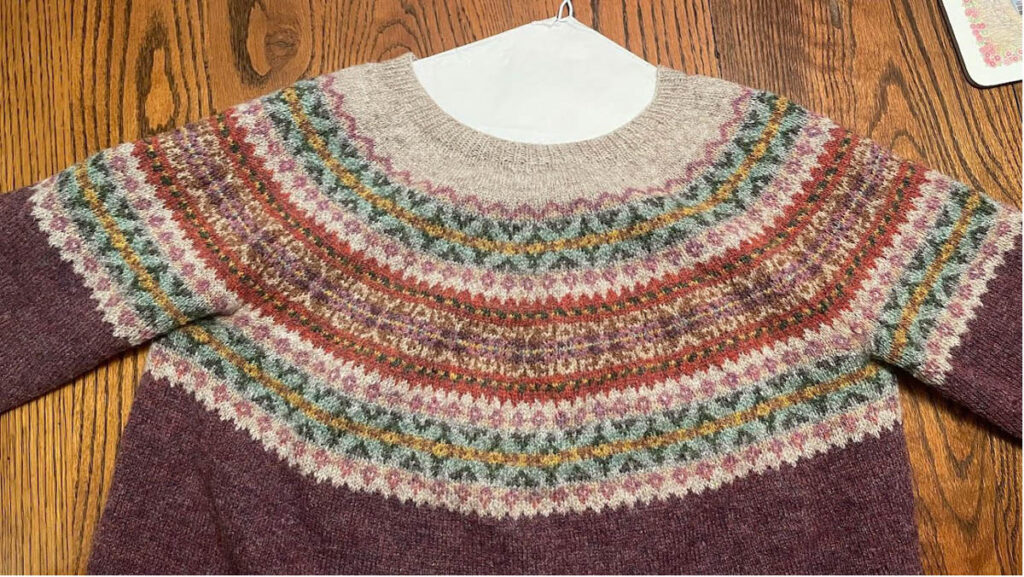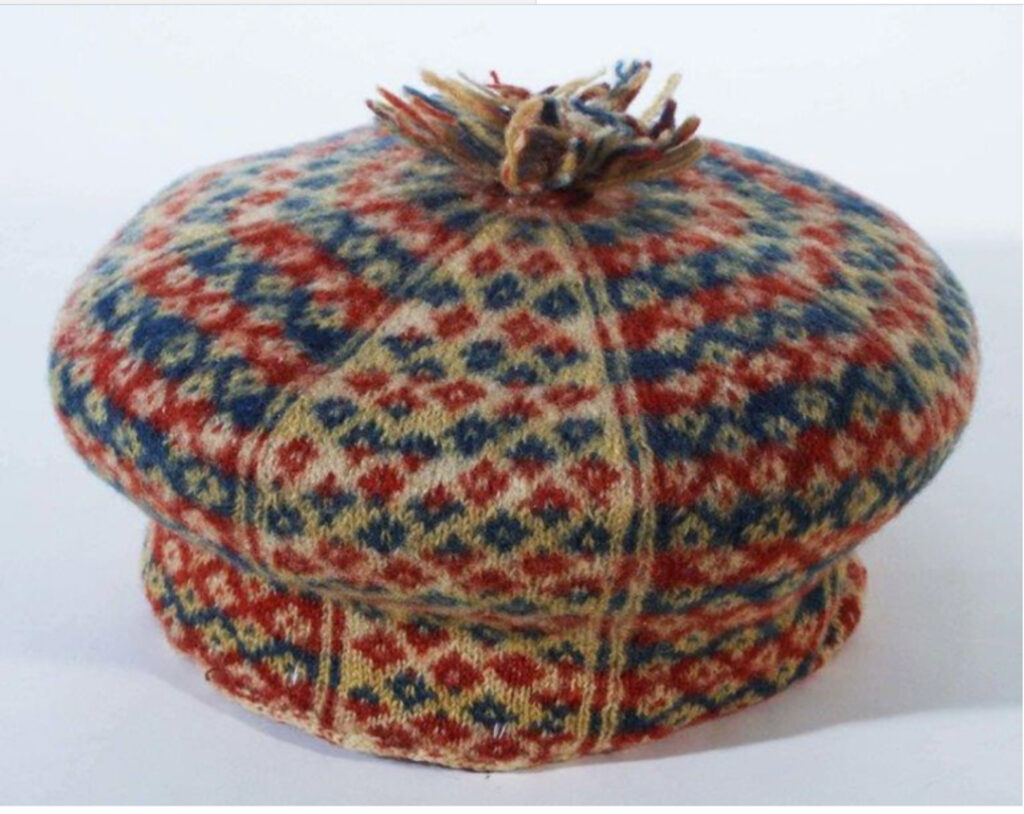Seamus Neufeld shares the history of Fair Isle knitting in appreciation of his mother’s heritage.
Craft cannot be separated from the land upon which it is created. This is clearly evident with the works of Shetland knitters, particularly Fair Isle ones. Fair Isle is in the archipelago known as the Shetland Islands located off the northern tip of Scotland. These islands are almost equidistant between Scotland and Norway (McHattie 39).
Fair Isle knitting is easily identifiable by its multi-coloured palette as well as its typical patterns and shapes. The techniques used to produce these textiles are unique to the Shetland Islands in the way the different coloured yarns are knitted throughout the entirety of the work (Carden 5).
Origins
Fair Isle knitting and its origins are documented mostly through oral histories. Some researchers go as far as to call some of the origin stories “folklore” (Pulliam 30). One of the seemingly longest-standing stories involves the Spanish Armada vessel, El Gran Grifon, that foundered in 1588 on Fair Isle: the marooned Spanish sailors supposedly taught these knitting techniques to local families The events involving El Gran Grifon are historically accurate, but there is no documented proof of multi-coloured knitting existing during this time in Spain. Thus the easily refutable tale and the realities of artifact preservation make it difficult to say when this style of knitting first emerged in the Shetland Islands (Pulliam 30-32).
The earliest extant examples of Fair Isle knitting date back to the mid-nineteenth century. In the absence of prior examples, the narrative surrounding this craft tradition being unique to the Shetland Islands is contested by some researchers (Pulliam 32). Some of the main countering theories link Fair Isle knitting with its resemblance to Norse/Scandinavian styles. This theory is supported by the consideration that the Shetland Islands previously were a Norwegian state before becoming part of Scotland in 1469 (Pulium 30). Another theory points to the trade routes that the Shetland Islands were situated within, and the likelihood that the style and technique were originally from Eastern Europe, namely Latvia and Lithuania (Pulliam 31). Outside of the Fair Isle knitting style/technique, however, it is known that knitting more generally has been part of the Shetland Islands’ culture for at least five hundred years (Ness 117).
Regardless of how long Fair Isle knitting has been going on (or its place of origin), this style of knitting and the community of craftspeople it has formed can no longer be separated from the island they are named after. While the recorded history of knitting in the Shetland Islands is legitimate by means of the oldest surviving knits, even within this sample there are holes in the documentation of the craft. For instance, most of the “authentic” Shetland Fair Isle knits have no label or written record of their knitters (Ness 117). It is known that these knitters were likely women (Ness 117). There is current research linking names found on self-addressed labels attached to knitted items sent to the James Pringle Company (a Scottish clothing manufacturer) in the 1950s to some of the Shetland makers. This research has shown that there are families in which this craft has been passed down, in some cases, for three generations (Ness 117).
It is notable that Fair Isle knitting and Shetland knitting on the whole are not a particularly large sector of the economy of the islands. The lack of financial gain is historically shown by how Shetland knits used to be bartered for things such as tea and gin (Ness 118). However. the way in which the work has established a cultural identity for the Shetland Islands, and Scotland as well (McHattie 40), is of immeasurable value (Carden 1).
Characteristics
Fair Isle knitting is identifiable by a few key traits. Traditionally, Fair Isle knits only consisted of a few colours (two or three). These coloured yarns would traditionally have been spun and dyed on the Islands, with the wool coming from the sheep which comprise the majority of the livestock in the Shetlands (McHattie 48). The patterns formed in the knitting resemble simple geometric shapes. This includes snowflakes, diamonds, stripes, and zig-zags (Pulliam 32). These early Fair Isle knits are seen within the two earliest available examples, both of them hats, at the Shetland Museum (Pulliam 31).
This image shows one of the two hats, this one being in the style of the now classic Tam O’Shanter (Pulliam 31). A small colour palette has been used, maybe four colours maximum. This hat also exemplifies the complex visual nature of the Fair Isle patterns, with many smaller geometric forms creating an all-in-all intricate-seeming design. To be noted, however, is that despite their seemingly complex nature, the reality of the techniques is much more straightforward. On one row of stitches, there are never more than two colors being used, with all of the yarns being knit through the work and therefore easy to manage (Carden 5). Knitters that practise Fair Isle techniques know that although the appearance is visually impressive, it is more of an illusion of complexity (Zlendich 1). These techniques are so intuitive that many of the oldest knitters seem to have learned the Fair Isle style through visual analysis of the work of other knitters and historical artifacts. Yet, most of the time, the style would have been taught through verbal instruction from a usually maternal teacher (Ness 117-118). This is in contrast to how most knitting patterns, both Fair Isle and otherwise, are taught today through diagrams and gridded pattern sheets (Carden 7).

Scarf from Fair Isle (centre), and two Shetland-patterned scarves, c. 1915, wool; Courtesy of Shetland Museum & Archives
The scarf in the centre of the above image is in the traditional Fair Isle style. The other two are clearly influenced by the style, but they were made on the mainland (Boak 1). The patterns in the centre scarf further show what are considered to be traditional geometric shapes. These, along with the horizontal repeats, are characteristic of all Fair Isle knits.

Fair Isle knitwear in the Shetland Museum; File: Fair Isle knitwear geograph-3936603-by-Julian-Paren.jpg
These sweaters are examples of the now-iconic Fair Isle style sweater that is responsible for the popularization of the work on a national and, eventually, international level (Carden 3).
Authenticity and value
I will now move on to discuss a sweater that some of the researchers I have previously cited would refer to as “inauthentic”. The sweater I am referring to was knitted in Hamilton, Ontario, by my mother, Karen Anne McVey, in the year 2019.
As you can see (above), the design of this sweater is clearly influenced by the horizontal repeats, geometric forms, and contrasting colours of traditional Fair Isle knits. It is also visually significant that there are never more than two colours being used in one row of stitches. This identifies the work as using Fair Isle knitting techniques.
For the purposes of this essay, and also to find out more about Fair Isle’s contemporary manifestations, I recorded a conversation with my mother about this sweater. I was initially interested in how the pattern was chosen, along with how she sourced her wool and her colour choices. She said, “[The pattern] was from an artist I follow… Marie Wallen… She’s British… I bought a book of hers… I used Jamieson’s Shetland wool… It’s a two-ply, yeah, which is traditionally used for Fair Isle sweaters. It’s made of 100% Shetland wool… [for the colour choice] I followed the pattern mainly, but I used some wool I had on hand” (Neufeld).
I was very interested in this dichotomy: a designer from England, and a desire by my mother to source her materials from the Shetland Islands. I then asked her about how she began knitting, and what attracted her to Fair Isle specifically: “[I’ve knitted] since I was a kid… it has been decades… My Mum knit. It was just something that was around and I was drawn to it… Fair Isle I started doing about five years ago… The initial attraction was I just liked the way it looked… there’s like the added bonus that it’s then part of our heritage” (Neufeld).
Then I moved on to what it is precisely that she enjoys about the lengthiness of the process. My mother replied, “I’m a process knitter. Like I would actually happily knit and rip out, knit and rip out, and never have a finished product. I’m not about the product… It’s very therapeutic” (Neufeld). To me this is a beautiful sentiment about a love for one’s craft. Perhaps this statement from my mother tells us about the signifa icance of this craft to the Shetland women of the past. In addition, I couldn’t help but feel as if my mother’s love for this craft influenced the way she raised me. She has always nurtured my love for the arts and crafts.
To this point she said, “It’s more to do with our values… making with your hands… [gains to be made] both personal and societal” (Neufeld). I wasn’t expecting her to say this. I thought she would say something along the lines of how she was invested in craft and therefore wanted me and my siblings to be part of it. The point she makes, instead, about personal and societal gains is important to me. As I move forward in my career as a craftsperson, I am constantly evaluating what it is I feel I am gaining from my work. At the same time I am also interested in how I can proceed in a way that others gain from it on a cultural level as well.
The value of Fair Isle knitting in my context is much bigger than could be immediately ascertained. It not only connects me as a craftsperson with my mother, but also teaches me the value of heritage craft. I may not be a strong enough knitter to call myself part of this group, but within my own practice, I can definitely see the links.
I make connections through this craft, and my family’s history, to the love I strive to express. Fair Isle knitting has a rich history of humble craftspeople. Although we may not know the names of all the individuals, the connections they have made through time are invaluable in forming a family invested in craft.
Works Cited
Arnold, Christine. “An Assessment of the Gender Dynamic in Fair Isle (Shetland) Knitwear.” Textile History, vol. 41, no. 1, 2010, pp. 86–98. Accessed 20 Mar. 2023.
Boak, Rachel. “Fair Isle Knitting.” Orkneybetweenislands.wordpress.com, 7 Dec. 2020, .
Butler, Richard W. “Fair Isle: Half a Century of Change.” Scottish Geographical Journal, vol. 135, no. 1-2, 3 Apr. 2019, pp. 123–138. Accessed 20 Mar. 2023.
Carden, Siún. “Authenticity and Place-Based Knitwear: Fair Isle and Aran Knitting in Shetland and the West of Ireland.” TEXTILE: Cloth and Culture, 15 Sept. 2022, pp. 1–18.,. Accessed 20 Mar. 2023.
McHattie, Lynn-Sayers, et al. “Craft, textiles, and cultural assets in the Northern Isles: innovation from tradition in the Shetland Islands.” Island Studies Journal, vol. 13, no. 2, Nov. 2018, pp. 39+. Gale Academic OneFile. 47 Accessed 20 Mar. 2023.
National Museum of Scotland. “Jersey.” National Museums Scotland.
Ness, Caroline. “’In the Loop 2: Knitting Origins and Evolution’, Shetland Museum and Archives.” Textile History, vol. 42, no. 1, May 2011, pp. 117–20. EBSCOhost.Accessed 24 Feb 2023.
Neufeld, Seamus. “Interview with Karen Anne McVey.” 20 Mar. 2023.
Pulliam, Deborah, “Traveling Stitches: Origins of Fair Isle Knitting” (2004). Textile Society of America Symposium Proceedings. 467. Accessed 20 Mar. 2023.
Zlendich, Jan. “Knitting Fair Isle Mittens and Gloves: 40 Great-Looking Designs.” Library Journal, vol. 127, no. 20, Dec. 2002, p. 124. Gale Academic OneFile. Accessed 20 Mar. 2023.



